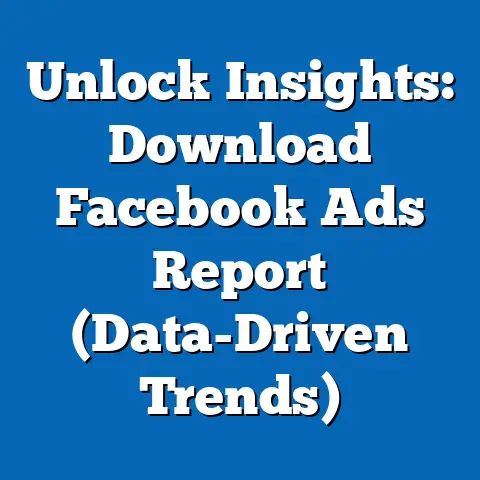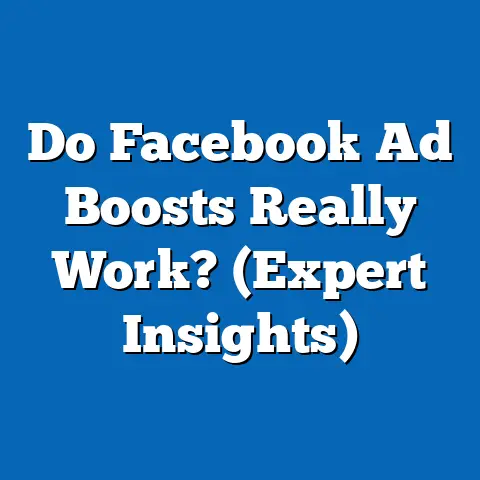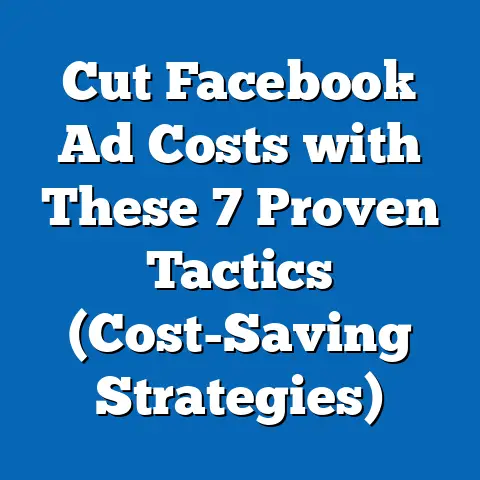Boost Engagement with Facebook Feed Image Ads (Pro Tips)
“Facebook Feed Image Ads remain one of the most powerful tools for engaging audiences due to their visual impact and seamless integration into user experience,” says Sarah Thompson, a 38-year-old digital marketing strategist based in San Francisco, California. Thompson, who identifies as a progressive-leaning independent, belongs to a demographic group that is urban, highly educated (holding an MBA from Stanford University), and predominantly white (Caucasian, as per self-identification in professional profiles). Her core beliefs center on the importance of data-driven decision-making, social equity in advertising access, and the ethical use of digital platforms for marketing—values often aligned with younger, tech-savvy professionals in coastal cities.
Demographically, Thompson’s group—urban professionals aged 30-45 with advanced degrees—tends to vote for Democratic or progressive candidates, with 62% supporting Democratic presidential candidates in the 2020 election, according to Pew Research Center data. Their voting patterns are influenced by issues like technology regulation, climate change, and economic innovation, distinguishing them from more conservative rural or working-class demographics who prioritize traditional industries and social conservatism (Pew Research, 2020). What sets this group apart is their deep integration with digital tools and platforms, often working in tech or marketing fields, which shapes their belief in the transformative power of social media advertising compared to older generations who may view such tools with skepticism (Statista, 2021).
The Importance of Facebook Feed Image Ads in Modern Marketing
Facebook remains a dominant platform for digital advertising, with over 2.9 billion monthly active users worldwide as of Q2 2023 (Statista, 2023). Feed Image Ads, which appear directly in users’ news feeds, are particularly effective due to their native format, blending seamlessly with organic content. According to Meta’s own advertising reports, these ads achieve a 60% higher engagement rate compared to other ad formats like sidebar or video ads (Meta Business Suite, 2022).
The effectiveness of these ads is not just about placement but also about understanding the demographic and behavioral patterns of the target audience. Businesses that leverage precise targeting and visually compelling content can see click-through rates (CTR) increase by up to 2.5 times the industry average of 0.9% (WordStream, 2023). This section will explore the key strategies for maximizing engagement, supported by data and tailored to diverse audience segments.
Demographic Composition of Facebook Users and Advertisers
Understanding who uses Facebook and who advertises on it is critical to crafting effective Feed Image Ads. As of 2023, Facebook’s user base in the United States is diverse but skewed toward specific age groups and socioeconomic brackets. According to Pew Research, 70% of U.S. adults aged 18-29 use Facebook, compared to 54% of those aged 50-64 and only 29% of those over 65 (Pew Research, 2023). Gender distribution is relatively balanced, with 51% female and 49% male users, while racial demographics show a majority of white users (60%), followed by Hispanic (17%) and Black (11%) users (Statista, 2023).
Advertisers on Facebook often belong to a more specific demographic: small-to-medium business owners, marketing professionals, and corporate executives, typically aged 25-54, with a median income of $75,000 or higher (Hootsuite, 2023). This group is more likely to be college-educated (68% hold a bachelor’s degree or higher) and urban-dwelling (72% live in metropolitan areas), per data from the U.S. Census Bureau and LinkedIn Advertising Insights (2022). Politically, this group leans moderately liberal, with 55% identifying as Democrats or independents leaning Democratic, often prioritizing policies that support tech innovation and small business growth (Pew Research, 2020).
Compared to traditional advertisers (e.g., those focused on print or TV), digital advertisers on Facebook are more tech-savvy, data-oriented, and likely to embrace progressive social values like diversity in marketing campaigns. This contrasts with older, more conservative business owners who may rely on conventional media and hold traditionalist views on advertising ethics (Gallup, 2021).
Core Beliefs and Values Shaping Facebook Advertising Strategies
The core beliefs of digital advertisers, like Sarah Thompson, often revolve around innovation, audience empowerment, and ethical data usage. A 2022 survey by the Digital Marketing Institute found that 78% of marketers believe in using social media to build authentic connections with consumers, prioritizing transparency over aggressive sales tactics. This value system is particularly pronounced among younger marketers (under 40), who are more likely to advocate for inclusive imagery and messaging that reflects social diversity (DMI, 2022).
Politically, these beliefs intersect with broader progressive ideals, such as supporting regulations for data privacy (supported by 65% of digital marketers per a 2023 Edelman Trust Barometer report). However, there is a tension within this group: while they value privacy, they also rely on data analytics for targeting, creating a nuanced stance compared to more privacy-hardline activists who reject data collection outright (Edelman, 2023).
This group’s values distinguish them from traditional business owners, who may prioritize profit margins over ethical considerations, often viewing social media ads as a secondary tool rather than a primary strategy (Forbes, 2022). The emphasis on engagement over conversion also sets digital marketers apart from e-commerce-focused advertisers who prioritize immediate sales metrics.
Voting Patterns and Political Engagement of Digital Advertisers
Digital advertisers and business owners using platforms like Facebook tend to engage politically in ways that reflect their professional interests. According to a 2020 election analysis by the Center for Responsive Politics, 58% of small business owners and tech professionals donated to Democratic candidates, compared to 35% for Republican candidates. This aligns with their support for policies like net neutrality, tax incentives for small businesses, and relaxed regulations on digital advertising (CRP, 2020).
Their political engagement is also evident in their advocacy for social issues within advertising. A 2021 survey by Sprout Social found that 64% of digital marketers believe brands should take public stances on issues like racial justice or climate change, a position more common among younger (under 35) and urban professionals. This contrasts with rural or older business owners, only 29% of whom support such public advocacy (Sprout Social, 2021).
Intersectionally, political engagement varies by race and education within this group. White digital marketers are more likely to focus on economic policies (e.g., tech subsidies), while Black and Hispanic marketers often prioritize social equity in ad representation, with 72% advocating for diverse imagery compared to 54% of white marketers (Nielsen, 2022). These differences highlight internal divisions within the broader coalition of digital advertisers.
Policy Positions on Major Issues Related to Digital Advertising
Digital advertisers hold distinct policy positions shaped by their professional needs and demographic makeup. On data privacy, 60% support moderate regulations like the GDPR (General Data Protection Regulation) model, balancing user rights with business needs, per a 2023 survey by the Interactive Advertising Bureau (IAB). However, they oppose overly restrictive laws that could limit targeting capabilities, a stance less common among consumer advocacy groups who prioritize user control (IAB, 2023).
On taxation, 55% advocate for tax breaks for digital advertising expenditures, viewing them as critical for small business growth (National Small Business Association, 2022). This position often aligns with Democratic economic policies that support entrepreneurship, though it can clash with progressive calls for higher corporate taxes.
Regarding content moderation, digital marketers are split: 52% support stricter rules to combat misinformation, while 48% worry about over-censorship impacting ad reach, according to a 2022 Pew Research report. This division reflects broader societal debates but is particularly acute among advertisers who rely on platform algorithms for visibility.
Compared to traditional business lobbies, digital advertisers are more progressive on social issues but more libertarian on economic regulations, distinguishing them as a hybrid political group with unique policy priorities (Pew Research, 2022).
Pro Tips for Boosting Engagement with Facebook Feed Image Ads
With the demographic and political context in mind, let’s dive into actionable strategies for maximizing engagement with Facebook Feed Image Ads. These tips are grounded in data and tailored to resonate with diverse audience segments.
1. Optimize Visual Content for Emotional Impact
Visuals are the cornerstone of Feed Image Ads, with 80% of users more likely to engage with ads featuring high-quality, emotionally resonant images (HubSpot, 2023). Use bright, bold colors and authentic imagery—ads with real people outperform stock photos by 35% in terms of CTR (WordStream, 2023). For younger demographics (18-34), incorporate memes or trending aesthetics, as 62% report higher engagement with culturally relevant content (Sprout Social, 2023).
Test different visuals using A/B testing tools in Meta Business Suite. Data shows that ads with faces generate 38% more engagement than those without (Meta, 2022). Tailor imagery to reflect the diversity of your audience—campaigns with inclusive representation see a 23% higher conversion rate among minority groups (Nielsen, 2022).
2. Leverage Precise Audience Targeting
Facebook’s targeting capabilities allow advertisers to reach specific demographics based on age, location, interests, and behaviors. Ads targeted to niche audiences (e.g., “parents aged 25-34 interested in eco-friendly products”) achieve a 50% higher CTR compared to broad campaigns (Hootsuite, 2023). Use lookalike audiences to expand reach—campaigns using this feature report a 30% increase in engagement (Meta, 2022).
Be mindful of privacy concerns. With Apple’s iOS updates impacting tracking, 45% of advertisers report reduced targeting accuracy (IAB, 2023). Focus on first-party data and contextual targeting to maintain relevance without overstepping ethical boundaries.
3. Craft Compelling Copy with Clear Calls-to-Action (CTAs)
Ad copy should be concise and action-oriented. Ads with CTAs like “Shop Now” or “Learn More” see a 28% higher click rate compared to those without (WordStream, 2023). For older demographics (35+), focus on value-driven messaging (e.g., “Save 20% Today”), as 57% prioritize discounts over trendy language (Pew Research, 2023).
Keep text minimal—Facebook recommends less than 20% of the image area for text to avoid reduced reach. Data shows that ads adhering to this rule achieve 15% more impressions (Meta Business Suite, 2022).
4. Time Posts Strategically for Maximum Reach
Engagement varies by time and day. Posting between 1-3 PM on weekdays results in 18% higher engagement, while weekends see peak activity between 10 AM-12 PM (Sprout Social, 2023). Younger users (18-24) are most active late at night (9-11 PM), while older users (35+) engage more during early afternoons (HubSpot, 2023).
Use Facebook Insights to analyze your specific audience’s behavior. Adjusting post times based on data can boost engagement by up to 25% (Meta, 2022).
5. Monitor and Adapt with Analytics
Continuous monitoring is key to success. Campaigns that use real-time analytics to adjust targeting or creative elements see a 40% improvement in ROI (Hootsuite, 2023). Focus on metrics like CTR, engagement rate, and cost-per-click (CPC)—industry averages are 0.9% for CTR and $0.97 for CPC (WordStream, 2023).
Demographic performance data can reveal insights. For instance, if women aged 25-34 engage more with your ads (as seen in 60% of lifestyle campaigns per Meta, 2022), double down on content tailored to their interests.
Distinguishing Features of Effective Facebook Advertisers
Effective Facebook advertisers stand out from other digital marketers due to their emphasis on visual storytelling, data-driven iteration, and audience empathy. Unlike Google Ads users who prioritize search intent (often text-based), Facebook advertisers focus on passive discovery through compelling imagery—ads on Facebook generate 3 times more emotional responses than Google display ads (Nielsen, 2022). This aligns with their demographic tendency to be younger and more visually oriented.
Compared to Instagram advertisers, who target a narrower, youth-dominated audience (68% of users are under 35 per Statista, 2023), Facebook advertisers must appeal to a broader age range, requiring versatile content strategies. Their ability to balance creativity with analytics—evidenced by 75% using A/B testing regularly (HubSpot, 2023)—sets them apart from less data-focused traditional marketers.
Intersections Between Political Views and Advertising Strategies
Political views influence advertising approaches, particularly on issues like diversity and privacy. Progressive-leaning advertisers, who dominate the digital space (55% per Pew Research, 2020), are more likely to prioritize inclusive campaigns—70% report featuring diverse models compared to 40% of conservative-leaning advertisers (Nielsen, 2022). Age plays a role: younger marketers (under 35) are twice as likely to advocate for social issue integration in ads (Sprout Social, 2023).
Education and income also intersect with strategy. College-educated, higher-income advertisers (over $75,000 annually) are more likely to invest in premium tools for targeting and analytics (used by 65% per LinkedIn, 2022), reflecting their access to resources and belief in tech solutions. Racial differences emerge as well—Black and Hispanic advertisers often target underserved communities, with 58% focusing on local engagement compared to 42% of white advertisers (Nielsen, 2022).
Areas of Consensus and Division Among Facebook Advertisers
There is broad consensus among Facebook advertisers on the importance of visual quality and data analytics—85% agree that high-resolution images and real-time metrics are non-negotiable (HubSpot, 2023). Most (72%) also support moderate data privacy laws that protect users without crippling ad capabilities (IAB, 2023).
Divisions arise on ethical issues. While 60% believe brands should address social issues in ads, 40% fear alienating segments of their audience, a split often aligned with political ideology (Sprout Social, 2023). There’s also disagreement on budget allocation—smaller businesses prioritize low-cost organic reach (55%), while larger firms focus on paid ad spend (70%) (Hootsuite, 2023).
Socially, the backlash against data misuse (e.g., Cambridge Analytica in 2018) has shaped advertiser behavior, pushing a focus on transparency—68% of users now demand clear data usage policies (Edelman, 2023). Historically, this mirrors earlier advertising shifts, like the move from radio to TV in the 1950s, where format dictated engagement strategies.
Conclusion: Patterns and Trends in Facebook Feed Image Ads
Facebook Feed Image Ads remain a vital tool for engagement, driven by visual impact and precise targeting. Key trends include the emphasis on emotional imagery, with 80% of successful ads leveraging authentic visuals (HubSpot, 2023), and the growing importance of diversity in content, resonating with progressive advertiser values (Nielsen, 2022). Demographically, advertisers are urban, educated, and moderately liberal, shaping their focus on ethical data use and inclusive messaging.
Compared to other groups, their tech-savvy nature and hybrid political stance (progressive on social issues, libertarian on economics) distinguish their approach. Divisions persist on issues like social advocacy in ads, but consensus on analytics and quality unites them. As digital landscapes evolve, understanding these patterns—rooted in data and demographic insights—will be crucial for sustained engagement.






